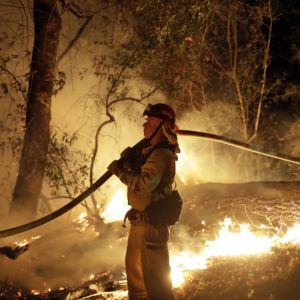The summer of 2020 has been a tale of three calamities for California.
A resurgence of COVID-19 cases, now approaching 700,000 statewide, forced Gov. Gavin Newsom in July to order the shutdown of indoor restaurants, bars and many other businesses that had reopened in late May. California was then afflicted by an early onset of wildfire season that, so far, has consumed more than 21.3 million acres, destroyed 1,800 buildings and led to at least seven deaths. The third misfortune for Californians this summer has been extreme heat that, in turn, has led to brownouts and blackouts on the state’s electric power grid.
Power interruptions are nothing new in California, which recorded nine last year. The largest occurred in October when Pacific Gas and Electric, the state’s largest utility, shut off electricity to 969,000 households across the state as part of a state-mandated wildfire mitigation plan designed to cut down on the inadvertent ignition of fires from power lines during periods of high risk. Some customers were without electricity for a week, with the average outage lasting 55 hours.
Not surprisingly, these recurring outages have generated a lot of finger-pointing. Newsom has lambasted the state’s grid operator, CAISO, saying its “failure to predict these shortages is unacceptable particularly given our state’s work to combat climate change … and (it) occurred without prior warning.”
CAISO responded by sending a letter to the governor stating that “(we) want to be clear about one factor that did not cause the rotating outages: California’s commitment to clean energy.”
Environmental groups claim that climate change is increasing the frequency and severity of California’s wildfires that, in turn, are contributing to electricity outages. They also argue that the state’s climate policies and heavy dependence on renewable energy are not major factors causing power interruptions.
However, a strong case can be made that California’s growing reliance on renewable energy sources is the principal cause of the recurring brownouts and blackouts. The state plans to remove all fossil fuels from its generation mix and rely entirely on renewable energy by 2045. To that end, California has added about 40 gigawatts of solar and wind to its power grid over the past decade, which now constitute more than one-third of installed capacity. Gas-fired generation fell by a like amount during the decade.
At the same time, most of state’s coal plants have been shuttered, one of the state’s two nuclear plants has been mothballed (with the other scheduled to close by 2025), and many gas-fired “peaker” units have fallen into disrepair. Put differently, California’s investor-owned utilities, complying with state mandates, have taken base-load “always on” generation offline and substituted equivalent amounts of intermittent power to the electric grid. (Interestingly, Los Angeles, with a municipal utility that gets 48 percent of its power from coal or gas, has avoided service interruptions.)
California’s outages typically occur in the evening when solar energy plunges, taking eight gigawatts off the grid, while the demand for power remains high. In the past, the state has been able to meet peak demand by importing electricity from neighboring states. But this summer, because of the heat wave that’s affecting all western states, less power has been available to ship to California. The state already boasts some of the highest retail electricity rates in the country, and buying expensive imported power on the spot market — when it’s available — imposes even greater burdens on the state’s households and businesses.
Without question, California’s transition to renewable energy has come at the expense of grid reliability. In response, the state’s utilities have started installing batteries to store solar energy that can be used as backup power when needed. Adding eight gigawatts of battery power to the grid promises to be an expensive and lengthy process.
Californians would be better served if the state’s politicians and environmentalists acknowledged that base-load nuclear and natural gas power plants are clean, cost-effective options for improving grid resiliency and reliability.
California’s COVID-19 epidemic will eventually go away, either from a vaccine or continued social distancing. The wildfires will burn themselves out. But the state’s electricity outages will continue indefinitely unless California alters course and recognizes the importance of base-load generation for keeping the lights on and the air conditioners humming during the “dog days” of summer.

